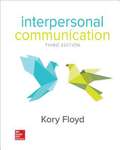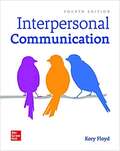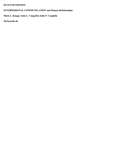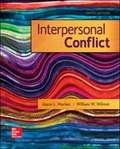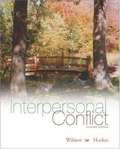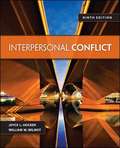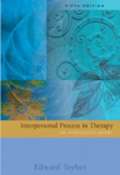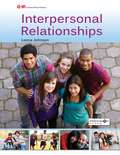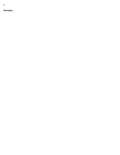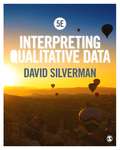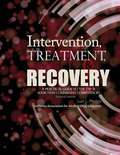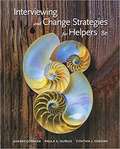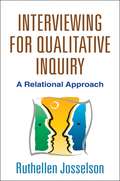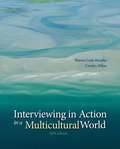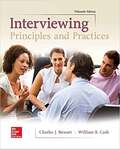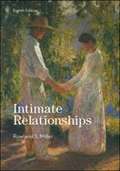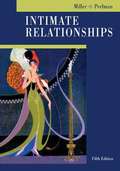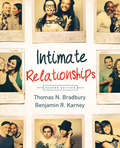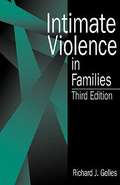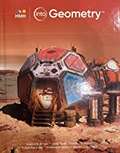- Table View
- List View
Interpersonal Communication
by Kory FloydKory Floyd McGraw-Hill Education, 22 May 2012 - Language Arts & Disciplines - 480 pages 0 Reviews Kory Floyd's approach to interpersonal communication stems from his research on the positive impact of communication on our health and well-being. Interpersonal Communication, 2e demonstrates how effective interpersonal communication can make students' lives better. With careful consideration given to the impact of computer-mediated communication, the program reflects the rapid changes of the modern world in which today’s students live and interact. The program also helps students understand and build interpersonal skills and choices for their academic, personal, and professional lives.
Interpersonal Communication
by Kory FloydInterpersonal Communication helps students see how communication not only affects their relationships but also influences their health, happiness, and quality of life. Author Kory Floyd encourages students to go beyond commonsense notions about communication and helps them see the value of investigating interpersonal processes - both face-to-face and online - in a systematic manner.
Interpersonal Communication and Human Relationships
by Anita L. Vangelisti Mark L. Knapp John P. CaughlinThis title introduces students to interpersonal communication principles and theories through the use of commonplace experiences, such as relationships with roommates, friends and co-workers. The book aims to motivate students to critically think about their own relational communication; it also peaks student interest in social science research. <p><p>MySearchLab is a part of the Knapp/Vangelisti/Caughlin program. Research and writing tools, including access to academic journals, help students explore human communication in even greater depth.
Interpersonal Conflict
by Joyce Hocker William WilmotInterpersonal Conflict explains the key dynamics of personal conflicts that we all face. Written for courses such as Communication and Conflict, Interpersonal Conflict, Conflict Management, Conflict and Negotiation, and Conflict in Personal Relationships, this textbook examines the central principles of effective conflict management in a wide variety of contexts--whether at home or on the job. Its combination of up-to-date research and examples gives students a theoretical and practical foundation in conflict management.
Interpersonal Conflict
by William W. Wilmot Joyce L. HockerTextbook examines the central principles of effective conflict management in a wide variety of contexts--from romantic relationships to the workplace. Its combination of up-to-date research and examples gives students a theoretical as well as a practical foundation in conflict management.
Interpersonal Conflict
by William W. Wilmot Joyce L. HockerInterpersonal Conflict explains the key dynamics of personal conflicts that we all face. Written for courses such as Communication and Conflict, Interpersonal Conflict, Conflict Management, Conflict and Negotiation, and Conflict in Personal Relationships, this textbook examines the central principles of effective conflict management in a wide variety of contexts--whether at home or on the job. Its combination of up-to-date research and examples gives students a theoretical and practical foundation in conflict management. Instructors and students can now access their course content through the Connect digital learning platform by purchasing either standalone Connect access or a bundle of print and Connect access. McGraw-Hill Connect® is a subscription-based learning service accessible online through your personal computer or tablet. Choose this option if your instructor will require Connect to be used in the course. Your subscription to Connect includes the following: * SmartBook® - an adaptive digital version of the course textbook that personalizes your reading experience based on how well you are learning the content. * Access to your instructor's homework assignments, quizzes, syllabus, notes, reminders, and other important files for the course. * Progress dashboards that quickly show how you are performing on your assignments and tips for improvement. * The option to purchase (for a small fee) a print version of the book. This binder-ready, loose-leaf version includes free shipping. Complete system requirements to use Connect can be found here: http://www. mheducation. com/highered/platforms/connect/training-support-students. html
Interpersonal Process in Therapy: An Integrative Model (5th edition)
by Edward TeyberThis resource for student therapists explains how to use the therapeutic relationship to help clients change. Using a wealth of real life examples including clinical vignettes and therapist-client dialogues, it demonstrates how the interpersonal process approach works. Sample topics include establishing a working alliance with the client, responding to painful feelings, developing a treatment focus, and terminating the therapeutic relationship. Teyber teaches at California State U. , San Bernardino. Annotation ©2005 Book News, Inc. , Portland, OR (booknews. com)
Interplay: The Process of Interpersonal Communication
by Ronald B. Adler Lawrence B. Rosenfeld Russell F. Proctor IIWith its unique blend of compelling topics and rich pedagogy, Interplay: The Process of Interpersonal Communication, Fifteenth Edition, offers a perfect balance of research and application to help students understand and improve their own relationships. No other book prepares students better to start improving their relationships beginning with the first day of class.
Interpreting Earth History: A Manual in Historical Geology
by Scott Ritter; Morris PetersenThe Eighth Edition of Interpreting Earth History continues a legacy of authoritative coverage, providing the flexibility and scope necessary to engage students with geological data from a variety of sources and scales. The authors carefully review the subjects covered in current historical geology courses and have tailored each stand-alone assignment to offer a clear, straightforward examination of pertinent topics. The content of this classroom-tested laboratory manual has been expanded and enhanced to include exercises on the Precambrian history of the Canadian Shield as well as an understanding of the stratigraphic, structural, and depositional history of North America during the Phanerozoic Eon. Now in full color, students will become more proficient in their ability to see and recognize geological patterns as well as the compositional and textural attributes of rocks and fossils.
Interpreting Qualitative Data: Methods For Analysing Talk, Text And Interaction
by David SilvermanIn this exciting and major updating of one the most important textbooks for beginning qualitative researchers, David Silverman seeks to match the typical chronology of experience faced by the student-reader. Earlier editions of Interpreting Qualitative Data largely sought to provide material for students to answer exam questions, yet the undergraduate encounter with methods training is increasingly assessed by students doing their own research project. In this context, the objective of the Third Edition is to offer undergraduates the kind of hands-on training in qualitative research required to guide them through the process.
Intervention, Treatment and Recovery: A Practical guide to the Tap 21 Addiction Counselling Competencies
by Lori L. PhelpsIntroduction to the Tap; Trans disciplinary Foundation I: Understanding Addiction; Trans disciplinary Foundation II:Treatment Knowledge; Trans disciplinary Foundation III: Application to Practice; Trans disciplinary Foundation IV: Professional Readiness; Practice Dimension I: Clinical Evaluation; Practice Dimension; Practice Dimension III; Practice Dimension IV; Practice Dimension V; Practice Dimension VI: Client, Family, and Community Education; Practice Dimension VII: Documentation; Practice Dimension VIII: Professional and Ethical Responsibilities.
Interviewing and Change Strategies for Helpers (Mindtap Course List)
by Sherry Cormier Cynthia J. Osborn Paula S. NuriusFully updated to reflect the latest research and issues, INTERVIEWING AND CHANGE STRATEGIES FOR HELPERS, Eighth Edition introduces you to the knowledge, skills, values, and tools needed by today's professional helpers. The book's conceptual foundation reflects four critical areas for helpers: core skills and attributes, effectiveness and evidence-based practice, diversity issues and ecological models, and critical commitments and ethical practice, using an interdisciplinary approach that reflects the authors' extensive experience in the fields of counseling, psychology, social work, and health and human services. The text skillfully combines evidence-based interviewing skills and evidence-based intervention change strategies, thus preparing you to work with clients representing a wide range of ages, cultural backgrounds, and challenges in living.
Interviewing for Qualitative Inquiry: A Relational Approach
by Ruthellen JosselsonEngagingly written, this book builds the reader's skills for conducting in-depth interviews designed to address a particular research question. With an emphasis on the dynamics of the research relationship, Ruthellen Josselson artfully demonstrates the steps of a successful interview. Each step is illustrated with excerpts from interviews on diverse topics. The book describes how to structure interviews effectively, develop questions that elicit meaningful narratives, cultivate skills for empathic listening and responding, avoid common pitfalls, and deal with problems that develop in an interview.Pedagogical features include:*Practice exercises adapted from Josselson's popular workshops.*Annotated examples of "good" and "bad" interviews.*A chapter on interviewing dos and don'ts.*Appendices with interview aids, sample follow-up questions, and a sample consent form.
Interviewing in Action in a Multicultural World, Fifth Edition
by Bianca Cody Murphy Carolyn DillonThis is a text for both graduate and undergraduate students preparing to work in a variety of fields: social work, counseling, psychology, human services, criminal justice, psychiatric nursing, school counselors, and a variety of other helping professions. The book provides students with the clinical wisdom and hands-on practice to fully develop their clinical interviewing skills.
Interviewing: Principles and Practices
by Charles J. Stewart William B. CashInterviewing: Principles and Practices, the most widely used text for the interviewing course, continues to reflect the growing sophistication with which interviewing is being approached, incorporating the ever-expanding body of research in all types of interview settings, recent communication theory, and the importance of equal opportunity laws on interviewing practices. <p><p> It provides the most thorough treatment of the basics of interviewing, including the complex interpersonal communication process, types and uses of questions, and the structuring of interviews from opening to closing. <p><p> The Connect course for this offering includes SmartBook, an adaptive reading and study experience which guides students to master, recall, and apply key concepts while providing automatically-graded assessments.
Intimate Relationships
by Rowland MillerDrawing on psychology, family studies, sociology, communication studies, and neuroscience, Intimate Relationships is a comprehensive and current overview of relationship science, written in an engaging and accessible style. Supported by SmartBookTM, McGraw-Hill’s adaptive and personalized reading experience, the eighth edition of this best-selling text includes hundreds of new discoveries and findings from the last three years, as well as over 600 new references.
Intimate Relationships (5th edition)
by Daniel Perlman Rowland S. MillerMiller's 5th edition of Intimate Relationships retains all of the qualities that made the trusted text a best seller, with a new organization that makes the material accessible to students. The text has engaging, accessible prose, a comprehensive reach across disciplines, vigorous standards of scholarship, and a personal appeal in its subject matter. The new edition is more concise with two reorganized chapters, but still packed with new developments and current research woven into every chapter. The authors illustrate the relevance of relationship science to readers' everyday lives, encouraging thought and analysis. This lively, comprehensive, user-friendly text provides students with the tools they need to succeed in this course.
Intimate Relationships (Second Edition)
by Benjamin R. Karney Thomas N. BradburyAs the first text to fully capture the excitement of today's research findings on couples, Intimate Relationships answers fascinating questions: How do relationships work? Why are they so hard sometimes? What are the principles that guide them? How can we use what we know to make them better?
Intimate Violence in Families
by Richard J. GellesIntimate Violence in Families has been thoroughly revised and updated in its third edition. Drawing on the latest research, this book dismantles many of the conventional myths hindering our understanding of family violence. Through an exploration of some of the major controversies in the field, Richard Gelles discusses various theories of intimate violence and the contributing social factors. This third edition includes a substantial expansion of material on hidden victims of familial violence-siblings, parents, and the elderly-as well as an examination of violence between gay and lesbian couples. While the first two editions of Intimate Violence in Families focused on physical abuse, here Gelles also explores neglect and emotional and psychological abuse, offering a much broader look at the full spectrum of familial abuse. Breaking important new ground, Gelles carefully examines what we know about intervention and treatment program effectiveness, with special attention to intensive family preservation programs and men's treatment programs. A major text for use in coursework on interpersonal violence, family violence, psychology, counseling, social work, and special issues in gender studies and sociology, Intimate Violence in Families, Third Edition will also provide essential information to professionals working in those areas.
Into Algebra 1: Student Edition 2020 (Into Algebra 1 Series)
by Timothy D. Kanold Edward B. Burger Juli K. DixonNIMAC-sourced textbook
Into Geometry: Student Edition 2020
by Houghton Mifflin HarcourtWelcome to Into Geometry'. In this program, you will develop skills and make sense of mathematics by solving real-world problems, using tools and strategies, and collaborating with your classmates.
Into Geometry: Student Edition 2020 (Into Geometry Series)
by Timothy D. Kanold Edward B. Burger Juli K. DixonNIMAC-sourced textbook
Into Geometry™ Getting Ready for High-Stakes Assessment (Into Geometry Series)
by Houghton Mifflin HarcourtNIMAC-sourced textbook
